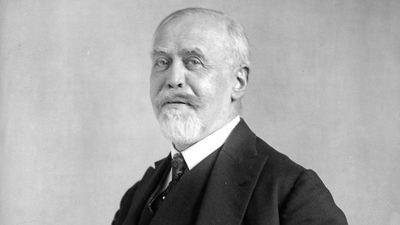
Musical Sorcery: Berlioz and Dukas | The Music
Musical Sorcery: Berlioz and Dukas | The Music
Berlioz Symphonie fantastique
Hector Berlioz (1803 - 1869) was one of the most flamboyant composers of the Romantic period. He lived in France and was hugely influenced throughout his life by Beethoven, Shakespeare and the Romantic literature of the day including works by Victor Hugo, Lord Byron and Percy Bysshe Shelley. He led an emotionally charged life and his music reflects this. It’s big, loud, demanding and extremely rich and vivid. His most famous (and controversial) piece by far is Symphonie fantastique.
The piece was written in 1830 and catapulted young Berlioz to fame. It is in five movements and tells a story. In other words, it is programmatic.

Portrait of Berlioz by Emile Signor, 1832
The story behind Symphonie fantastique
In 1827, Berlioz was a struggling young composer living in Paris when he saw a travelling theatre company from England performing plays by Shakespeare. On stage was a beautiful young Irish actress called Harriet Smithson playing the roles of Ophelia in Hamlet and Juliet in Romeo and Juliet. Berlioz fell in love with her at first sight and spent the following five years pursuing her. He wrote her letters, followed her around Paris, saw all her performances and repeatedly asked her to marry him. Harriet did not return his affections.
In despair, Berlioz wrote Symphonie fantastique, which tells an alternative story of his love for Harriet and includes a beautiful tune that occurs in every movement and represents her. It was first performed in 1830. After the piece became successful, Harriet was so flattered (despite being cast as an ugly witch in the final movement!) that in 1833 she finally agreed to marry Berlioz. The marriage was not a success. After their child Louis was born in 1834, Harriet found herself stranded in France, away from her acting troupe and without work. She turned to drink and then slowly lost her mind. Eventually Hector had her committed to a mental hospital. Although he married again and became one of France’s most famous composers, he never fully got over the loss of Harriet.
The story within Symphonie fantastique
The symphony is in five movements and tells the following story:
Daydreams - Passions
A young artist is hopelessly in love with a beautiful young actress.
Whenever he thinks of her he is haunted by a beautiful melody.
A Ball
Amid the swirling waltz at a party, the artist sees his beloved through the crowds.
In the Meadows
In the countryside the artist listens to shepherds calling to each other on their pipes. The thought of his beloved comes into his head and he angrily pushes it away. A distant storm closes in.
March to the Scaffold
Sickened by unrequited love, the artist has a nightmare in which he imagines that he has killed his beloved and is executed by guillotine. As the blade comes down to chop off his head, he hears a fragment of her tune.
Sabbath Night's Dream
Still dreaming, the artist has a vision of a witches' sabbath, where a terrifying troop of ghosts and sorcerers gather for his funeral. His beloved appears but she has turned into an ugly witch. She casts a spell and dances around her cauldron with a group of witches.
Berlioz outlined this story in notes that formed part of the musical score for the piece. He was the first composer to describe events in music so explicitly and with this piece he invented the idea of the programmatic symphony. Programmatic music is simply music that tells a story. After the success of this piece, many other composers followed suit and programmatic symphonic music became one of the most important forms of music of the late 19th century.
More on the music
Berlioz uses one melody throughout his symphony to represent Harriet. This is called the idée fixe (fixed idea). Most symphonies of the time used different themes from which to build their various movements, but this one appears in every movement and Berlioz transforms it to suit the mood and story of each section. He was one of the first composers to do this. It helps to tell his story and to give the symphony cohesion.

The full idée fixe is long and complicated but in this clip from one of his TV shows, the great American composer and conductor Leonard Bernstein demonstrates it in a couple of minutes.
A Ball (the second movement of the symphony, but the first one that we will hear) is written as a waltz, a dance with three beats in each bar (like oom-pah-pah). Berlioz transforms the idée fixe to fit into waltz time.
In March to the Scaffold, Berlioz uses two marches – a slow, sad one and a fast, frenzied one. At the end of the movement he adds his idée fixe tune to represent Harriet. In a really gruesome twist, he cuts the tune short with a musical representation of the guillotine blade falling and the severed head falling into a basket below.
In the final movement, Sabbath Night’s Dream, the idée fixe returns as a dance tune in 6/8 time and eventually in a distorted form to match the grotesque transformation of the beloved.
Symphonie fantastique links
The London Symphony Orchestra has filmed the orchestra playing the fourth (March to the Scaffold) and fifth (Sabbath Night’s Dream) movements of Berlioz’s piece with multiple cameras. Here you can decide which part of the orchestra to focus on by switching between cameras yourself.
Below is a complete performance from the BBC Proms in 2013, performed by the Bavarian Radio Symphony Orchestra conducted by Mariss Jansons.
The three movements the Scottish Chamber Orchestra will be playing start at:
- A Ball 18:52
- March to the Scaffold 41:19
- Sabbath Night’s Dream 46:35
Dukas The Sorcerer's Apprentice
Paul Dukas (1865 - 1935) was a shy and serious man who left very little music due to his highly critical standards – he threw away almost everything he wrote as he was worried it wasn’t good enough. Fortunately, he didn’t have to earn his living by composing, since he worked as a music critic and teacher. Luckily for us, his tone poem The Sorcerer’s Apprentice, written in 1897, survived and became famous when it was used in Walt Disney’s film Fantasia in 1940.

Paul Dukas (1865-1935)
The Sorcerer's Apprentice (originally called L'apprenti sorcier in French) is subtitled ‘Scherzo after a ballad by Goethe’. The piece was based on Johann Wolfgang von Goethe's 1797 poem of the same name.
This one movement epic tells the familiar tale of a wizard’s assistant left alone with the task of mopping the workroom. Bored by the task, the apprentice casts a spell that makes the broom come to life to do the work for him. Things quickly get out of hand…
The Sorcerer's Apprentice links
Watch The Sorcerer's Apprentice being performed by the Moscow City Symphony - Russian Philharmonic conducted by Michail Jurowski below.
Here's The Sorcerer's Apprentice as featured in Disney's Fantasia.
More on the music
Dukas’ piece follows the story as told by Goethe quite closely. It opens peacefully, evoking the calm state of the workshop before the chaos that follows. Mysterious chords are played by muted strings and the flutes, and the main melody is introduced, played slowly by intertwined clarinet, oboe and flute. This tune returns many times throughout the piece. Outbursts of scurrying strings hint at what is to come.
After a few minutes the theme appears as a sort of march given a faintly comic feel by being in triple time (multiples of three). The strings play cascades of notes which suggest the water that eventually floods the room. Crashing cymbals represent the apprentice desperately hacking at the broom to make it stop. Of course, this only makes things worse as the broom multiplies itself, so the music fragments and accelerates. Fortunately for the apprentice, the sorcerer returns and puts a stop to the chaos.
Here’s a fragment of the recurring tune with added words.




